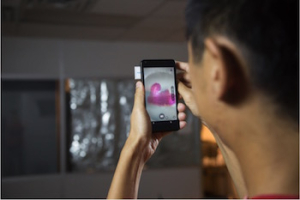A professor and three graduate students in the electrical and computer engineering department at the UH Cullen College of Engineering published the most downloaded paper of 2015 in a major scientific journal.
Associate professor Wei-Chuan Shih and his graduate students Yulung Sung, Jenn Jeang and Chia- Hsuing Lee published a paper last year in the Journal of Biomedical Optics detailing a manufacturing process for making optical lenses that can turn a smartphone into a microscope. The fabrication process shares great similarity to inkjet printing in mainstream computer printers. However, instead of printing texts and figures on a piece of paper, Shih’s process prints 3-dimensional lens objects.
The article, titled “Fabricating optical lenses by inkjet printing and heat-assisted in situ curing of polydimethysiloxane for smartphone microscopy,” was downloaded approximately 11,000 times since its publication in May.
“[The] paper has been downloaded 10,929 times since publication, 3,000 downloads more than the runner up,” said Gwen Weerts, managing editor of journals for the Society of Photographic Instrumentation Engineers (SPIE), one of the largest professional society for optical scientists and engineers.
In addition to the popularity of Shih’s research article among those in the academic and research communities, the groundbreaking lens garnered international media attention from outlets including CNBC and Slate, spurring the researchers to build a business, “DotLens,” around their invention.
The DotLens is made out of polydimethylsiloxane (PDMS), a material commonly used in soft lithography and microfluidics, and can magnify images up to 120 times. Combined with smartphone’s digital zoom, a magnification exceeding 500 times can be easily achieved.
The low cost and ease of using the lens make it ideal for researchers working in the field or for students in the classroom. It also could have clinical applications, allowing small or isolated clinics to share images with specialists located elsewhere. Shih said these factors may have contributed to his article’s popularity, piquing the curiosity of researchers all over the world who are interested in making similar lenses in their own laboratories.
“We start with the liquid polymer and put it through what looks like an inkjet printer,” Shih said. “We are printing 10-15 microliters of “ink” and when they dry, they form the curved surface, becoming a lens.”
This process also allows for a mass production of the lenses, Shih added.
“You can print thousands or tens of thousands of lenses with just one jar of polymer,” he said.
The Journal of Biomedical Optics (JBO) publishes peer-reviewed papers on the use of modern optical technology for improved health care and biomedical research.
